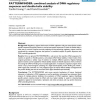BMCBI
2004
13 years 12 months ago
2004
Background: Kernel-based learning algorithms are among the most advanced machine learning methods and have been successfully applied to a variety of sequence classification tasks ...
BMCBI
2004
13 years 12 months ago
2004
Background: Regulatory regions that function in DNA replication and gene transcription contain specific sequences that bind proteins as well as less-specific sequences in which th...
BMCBI
2004
13 years 12 months ago
2004
Background: Annotation of sequences that share little similarity to sequences of known function remains a major obstacle in genome annotation. Some of the best methods of detectin...
BMCBI
2004
13 years 12 months ago
2004
Background: Transposable elements (TE) are mobile genetic entities present in nearly all genomes. Previous work has shown that TEs tend to have a different nucleotide composition ...
JC
2007
14 years 13 sec ago
2007
Extensible lattice sequences have been proposed and studied in [5–7]. For the special case of extensible Korobov sequences, parameters can be found in [6]. The searches made to ...
BMCBI
2005
14 years 7 min ago
2005
Background: Genomic sequence data cannot be fully appreciated in isolation. Comparative genomics
BMCBI
2005
14 years 8 min ago
2005
Background: The allele frequencies of single-nucleotide polymorphisms (SNPs) are needed to select an optimal subset of common SNPs for use in association studies. Sequence-based m...
BMCBI
2005
14 years 20 min ago
2005
Background: Whole-genome sequencing projects are rapidly producing an enormous number of new sequences. Consequently almost every family of proteins now contains hundreds of membe...
BMCBI
2005
14 years 40 min ago
2005
Background: Several problems exist with current methods used to align DNA sequences for comparative sequence analysis. Most dynamic programming algorithms assume that conserved se...
BMCBI
2005
14 years 40 min ago
2005
Background: During the last few years, DNA sequence analysis has become one of the primary means of taxonomic identification of species, particularly so for species that are minut...






